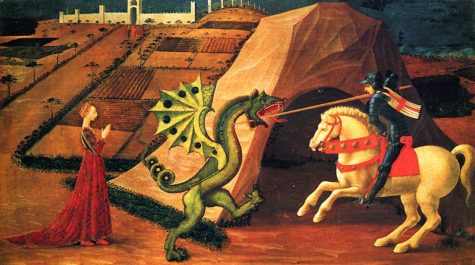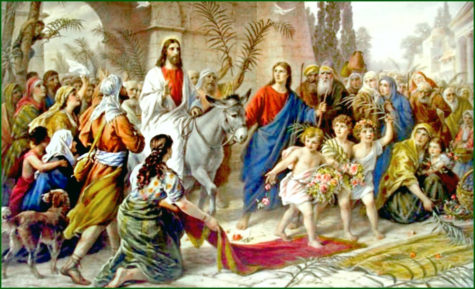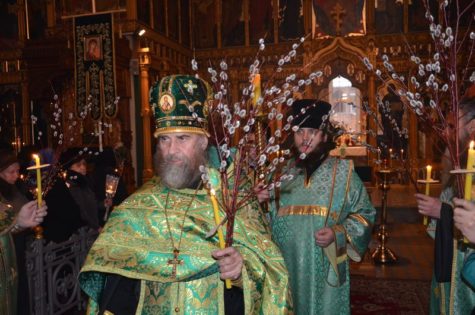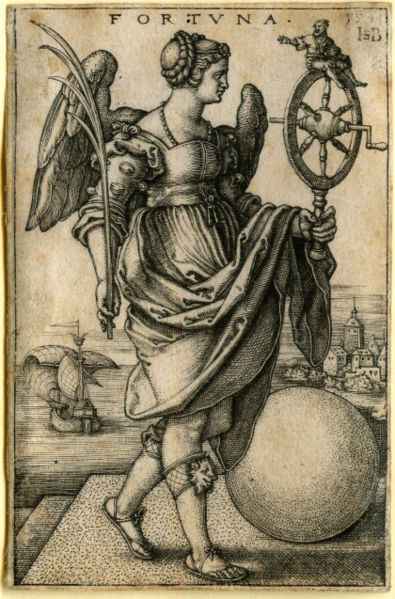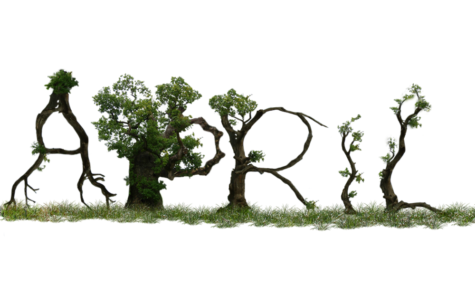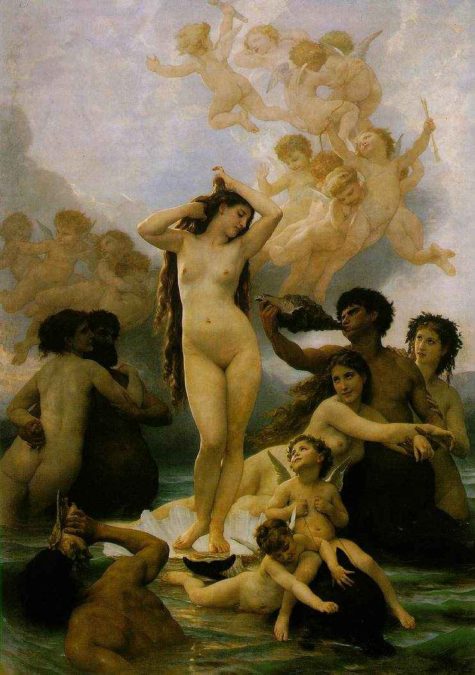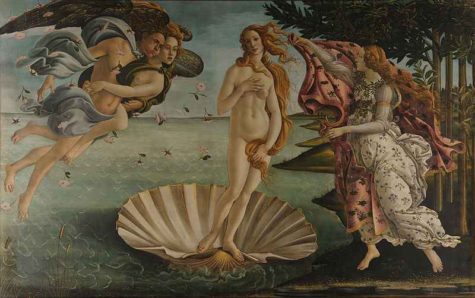April
Saint George’s Day is celebrated on April 23, the traditionally accepted date of the saint’s death in AD 303. For those Eastern Orthodox Churches which use the Julian calendar, this date currently falls on the day of 6 May of the Gregorian calendar. In Turkish culture the day is known as Hıdırellez or Xıdır Nəbi and is symbolic of spring renewal.
It is also believed to be a magical day when all evil spells can be broken. It was believed that the saint helps the crops to grow and blesses the morning dew, so early in the morning they walked in the pastures and meadows and collected dew, washed their face, hands and feet in it for good luck and even in some rural parts of Bulgaria it was a custom to roll in it naked.
In Romania, people celebrate St. George – ‘Sfantul Gheorghe’ – and in certain regions, including Bucovina, people will still plant cut willow branches in freshly cut earth and place them at the entrances to their homes.
Many Christian denominations in Syria celebrate St George’s Day, especially in the Homs Governorate. They do this by dressing small children as dragons and chasing them through the streets whilst beating them with clubs and batons. It is a very special time of year, after the beatings folks will enjoy a sit down dinner and dancing.
Saint George’s Day is the feast day of Saint George as celebrated by various Christian Churches and by the several nations, kingdoms, countries, and cities of which Saint George is the patron saint.
Since Easter often falls close to Saint George’s Day, the church celebration of the feast may be moved to accommodate the Easter Festivities. Similarly, the Eastern Orthodox celebration of the feast moves accordingly to the first Monday after Easter or, as it is sometimes called, to the Monday of Bright Week.
Some Orthodox Churches have additional feasts dedicated to St George. The country of Georgia celebrates the feast of St. George on April 23, and, more prominently, November 10 (Julian calendar), which currently fall on May 6 and November 23 (Gregorian calendar), respectively.
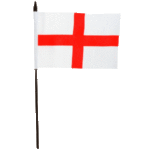 St George’s Day was a major feast and national holiday in England on a par with Christmas from the early 15th century. The Cross of St. George was flown in 1497 by John Cabot on his voyage to discover Newfoundland and later by Sir Francis Drake and Sir Walter Raleigh. In 1620 it was the flag that was flown on the foremast of the Mayflower when the Pilgrim Fathers arrived in Plymouth, Massachusetts.
St George’s Day was a major feast and national holiday in England on a par with Christmas from the early 15th century. The Cross of St. George was flown in 1497 by John Cabot on his voyage to discover Newfoundland and later by Sir Francis Drake and Sir Walter Raleigh. In 1620 it was the flag that was flown on the foremast of the Mayflower when the Pilgrim Fathers arrived in Plymouth, Massachusetts.
The tradition of celebration St George’s day had waned by the end of the 18th century after the union of England and Scotland. Nevertheless, the link with St. George continues today, for example Salisbury holds an annual St. George’s Day pageant, the origins of which are believed to go back to the 13th century. In recent years the popularity of St. George’s Day appears to be increasing gradually. Today, St. George’s day may be celebrated with anything English including morris dancing and Punch and Judy shows.
A traditional custom on St George’s day is to wear a red rose in one’s lapel, though this is no longer widely practiced. Another custom is to fly or adorn the St George’s Cross flag in some way: pubs in particular can be seen on April 23 festooned with garlands of St George’s crosses. It is customary for the hymn “Jerusalem” to be sung in cathedrals, churches and chapels on St George’s Day, or on the Sunday closest to it. Traditional English food and drink may be consumed.
In the Valencian city of Alcoi, Saint George’s Day is commemorated as a thanksgiving celebration for the proclaimed aid the Saint provided to the Christian troops fighting the Muslims in the siege of the city. Its citizens commemorate the day with a festivity in which thousands of people parade in medieval costumes, forming two “armies” of Moors and Christians and re-enacting the siege that gave the city to the Christians.
The Serbian St George’s Day is called Đurđevdan and is celebrated on 6 May every year, as the Serbian Orthodox Church uses the Julian, Old Style calendar. Đurđevdan is also celebrated by both Orthodox and Muslim Romani and Muslim Gorani. Đurđevdan is celebrated, especially, in the areas of Raška in Serbia, and is marked by morning picnics, music, and folk dances.
In Russia, St George’s Day (Гергьовден, Gergyovden) is a public holiday that takes place on 6 May each year. It is possibly the most celebrated name day in the country. A common ritual is to prepare and eat a whole lamb, which is an ancient practice possibly related to Slavic pagan sacrificial traditions and the fact that St George is the patron saint of shepherds.
A Protective Blessing Ritual for Saint George’s Day:
In many communities, Saint George’s Day was the day animals were lead out into the field, thus protective, blessing rituals abound. Here’s one:
- Lead all healthy animals three times around the perimeter of their field, barn or home, always in a sunwise direction.
- The person leading the parade carries a lit torch.
- The person bringing up the rear holds an open padlock in one hand, the key in the other hand.
- After the third round, the animals are lead back into the barn.
- Turn the key in the lock.
- Throw the key into a river or stream, while preserving the now permanently locked padlock.
Dragons and Dragon’s Blood:
St. George is credited with having slain a fearsome dragon to save the life of a virgin. The Dragon means different things to different peoples. In some medieval traditions it is linked with the devil or Satan, hence the carvings and windows depicting St George, (or sometimes St Michael), slaying one.
But the Dragon has far older associations in which it represents the life force of the land. In the Craft we often refer to the Earth Dragon, a great coiled beast who sleeps within the Earth and who can be called upon to work healing for the planet. The Earth Dragon is often invoked in cases of potential ecological danger. King Arthur’s father was named Uther Pendragon, and it is thought that his name shows that he was a defender of the land. The Dragon is a symbol of Wales and appears on the country’s flag.
Dragon’s blood is not the blood of some luckless lizard, but the resin of the palm calimus draco. Magically it is used for spells of protection, exorcism and sexual potency. Added to incenses it increases their potency and drives away all negativity. On its own Dragon’s blood can be burnt at an open window to secure a lover’s return, and a piece of the resin placed under the mattress is said to cure impotence. In the past Dragon’s Blood was used medicinally to cure diarrhoea, dysentery and even syphilis. Like many other resins it is also used to stop bleeding wounds.
Sources:
In April, the thunderstorms of March are beginning to subside, and the wind picks up. Seeds are being blown about on the breezes, spreading life all around from one place to the next. In fact, this month’s full moon is the aptly named Wind Moon, although in some traditions this lunar cycle is often known as the Seed Moon.
Trees have buds on them, spring daffodils and tulips abound, and the birds are nesting once more. Spring is well underway now that the soggy chill of March is past, and while it’s still soggy in a lot of places, there’s hope yet, because as the saying goes, those April showers will bring us flowers in May.
Now that April’s here, It’s a time to welcome new beginnings, and do magic related to conceiving new ideas and projects. Much like March, this is a time of conception and fertility and new growth. What do you want to see taking root and growing in your life?
Correspondences:
- Colors: Bright primary colors — red, yellow, blue — and their combinations
- Gemstones: Quartz, selenite, angelite
- Trees: Hazel, forsythia, lilac, willow
- Gods: Ishtar, Tawaret, Venus, Herne, Cernunnos
- Herbs: Dandelion, milkweed, dogwood, fennel, dill
- Element: Air
It’s the time to stop planning, and start doing. Take all those ideas you’ve had brewing for the past couple of months, and make them come to fruition. This is an excellent time to work on magic related to new beginnings. Looking to bring new love into your life, or conceive or adopt a child? This is the time to do those workings.
source:Paganwiccan
What follows is a list (in alphabetical order) of the names given to the April moon. Also listed is the tradition and/or origin of that moon name:
Ashes Moon ~Taos
Awakening Moon ~Neo Pagan
Big Leaves Moon ~Apache
Big Spring Moon ~Creek, Cree
Broken Snow Shoe Moon ~Anishnaabe
Budding Moon ~Mohawk
Corn Planting Moon ~Winnebago
Egg Moon ~Cherokee, Algonquin
Eostre Moon ~other
Fish Moon ~Algonquin
Flowers Moon ~Pomo, Cherokee
Frog Moon ~Assiniboine, Janic
Geese Egg Moon ~Cheyenne
Geese Return Moon ~Dakota
Grass Moon ~other
Gray Goose Moon ~Cree
Green Grass Moon ~Sioux
Growing Moon ~Celtic
Hare Moon ~other
Ice Breaking Moon ~Arapaho
Indian Corn Moon ~Algonquin
Leaf Moon ~Kiowa
Leaf Split Moon ~San Juan
Ostarmanoth Moon ~Old English
Pink Moon ~Algonquin
Planter’s Moon ~Colonial American, Algonquin
Red Grass Moon ~other
Seed Moon ~Medieval English
Sprouting Grass Moon ~Algonquin
Spring Moon ~Passamaquoddy
Strawberry Moon ~Natchez
Sugar Maker Moon ~Abernaki
Wildcat Moon ~Choctaw
Wind Breaks Moon ~Hopi
Yellow Moon ~Pima
Palm Sunday is a Christian moveable feast that falls on the Sunday before Easter. The feast commemorates Jesus’ triumphal entry into Jerusalem, an event mentioned in each of the four canonical Gospels.
In many Christian denominations, worship services on Palm Sunday include a procession of the faithful carrying palms, representing the palm branches the crowd scattered in front of Jesus as he rode into Jerusalem. The difficulty of procuring palms in unfavorable climates led to their substitution with branches of native trees, including box, olive, willow, and yew. The Sunday was often named after these substitute trees, as in Yew Sunday, or by the general term Branch Sunday.
In the Greco-Roman culture of the Roman Empire, which strongly influenced Christian tradition, the palm branch was a symbol of triumph and victory. It became the most common attribute of the goddess Nike or Victory. For contemporary Roman observers, the procession would have evoked the Roman triumph, when the triumphator laid down his arms and wore the toga, the civilian garment of peace that might be ornamented with emblems of the palm.
Although the Epistles of Paul refer to Jesus as “triumphing”, the entry into Jerusalem may not have been regularly pictured as a triumphal procession in this sense before the 13th century. In ancient Egyptian religion, the palm was carried in funeral processions and represented eternal life. The palm branch later was used as a symbol of Christian martyrs and their spiritual victory or triumph over death.
Variations of the traditional observances:
In Latvia, Palm Sunday is called “Pussy Willow Sunday”, and pussy willows – symbolizing new life – are blessed and distributed to the faithful. Children are often awakened that morning with ritualistic swats of a willow branch.
In Bulgaria, Palm Sunday is known as Tsvetnitsa (tsvete, “flower”) or Vrabnitsa (varba, “willow”), or Flower’s Day. People with flower-related names (e.g., Lilia, Margarita, Nevena, Ralitsa, Rosa, Temenuzhka, Tsvetan, Tsvetana, Tsvetelin, Tsvetelina, Tsvetko, Violeta, Yavor, Zdravko, Zjumbjul, etc.) celebrate this day as their name day.
In Finland, it is popular for children to dress up as Easter witches and go door to door in neighborhoods for coins and candy. This is an old Karelian custom called Virpominen.
In the 15th through the 17th centuries in England, Palm Sunday was frequently marked by the burning of Jack-‘o’-Lent figures. This was a straw effigy which would be stoned and abused on Ash Wednesday, and kept in the parish for burning on Palm Sunday. The symbolism was believed to be a kind of revenge on Judas Iscariot, who had betrayed Christ. The effigy could also have represented the hated figure of Winter, whose destruction prepares the way for Spring.
In Oriental Orthodox churches, palm fronds are distributed at the front of the church at the sanctuary steps, in India the sanctuary itself having been strewn with marigolds, and the congregation proceeds through and outside the church.
In the Church of Pakistan (a member of the Anglican Communion), the faithful on Palm Sunday carry palm branches into the church as they sing Psalm 24.
In many Protestant churches, children are given palms, and then walk in procession around the inside of the church.
In Hoegaarden, Belgium one of the last remaining Palm Sunday processions takes place every year. A fellowship of Twelve Apostles carries a wooden statue of Christ around the town, while children go door to door offering the palms (box) for coins.
In Italy, palm leaves are used along with small olive branches, readily available in the Mediterranean climate. These are placed at house entrances (for instance, hanging above the door) to last until the following year’s Palm Sunday. For this reason, usually palm leaves are not used whole, due to their size; instead, leaf stripes are braided into smaller shapes. Small olive branches are also often used to decorate traditional Easter cakes, along with other symbols of birth, like eggs.
When Christianity came to Lithuania, the plants which sprouted earliest were honored during spring feasts. The “verba” or “dwarfed spuce” is used instead. According to tradition, on the Saturday before Palm Sunday the Lithuanians take special care in choosing and cutting well-formed branches, which the women-folk decorate with flowers. The flowers are meticulously tied onto the branches, making the “Verba”
In the Saxon regions of the Netherlands, crosses are decorated with candy and bread, made in the form of a rooster. In the Diocese of Groningen-Leeuwarden, a great procession with oil lamps is held the night before Palm Sunday in honor of the Sorrowful Mother of Warfhuizen.
Many Polish towns and villages (the best known are Lipnica Murowana in Małopolska and Łyse) organize artificial palm competitions. The biggest of those reach above 30 meters in length; for example, the highest palm in 2008 was 33.39 meters.
In Elche, Spain, the location of Palmeral of Elche (the biggest palm grove in Europe), there is a tradition of tying and covering palm leaves to whiten them away from sunlight, and then drying and braiding them in elaborate shapes. A Spanish rhyming proverb states:
Domingo de Ramos,
quien no estrena algo,
se le caen las manos
On Palm Sunday,
the hands drop off of those who fail to wear something new.
In Wales, Palm Sunday in called ‘Sul y Blodau’ (‘Flowering Sunday’) and it is traditional to decorate graves with flowers on that day, especially in the industrial towns and villages of south Wales.
Source: Wikipedia
A-ma is the patroness of all fishers and sailors in the region of Macao, where today (April 9) is her festival day and her birthday. Also sometimes called Matsu, this divine figure offers safety in any of life’s literal or figurative storms, often by teaching magical weather charms. Legend says that A-ma achieved enlightenment and a mastery of magic at the young age of 28, after which she went to Nirvana and became a Goddess.
- Themes: Water; Providence; Protection; Magick; Weather
- Symbols: Fish; Red cloth
To Do Today:
In Portugal, the day is spent enjoying parades for the goddess, eating lots of seafood, adorning altars with food and incense, and setting off firecrackers in A-ma’s honor. So by all means, have some type of fish today (if you’re allergic, eat fish-shaped candy instead). Before eating it, thank the founder of your feast with this prayer:
A-ma thank you for your providence and protection.
Let the seas of my soul find solace in you;
Let the waters of my spirit be refreshed in you. So be it.
Wear any red-colored clothing today to commemorate A-ma’s birthday and inspire her magical assistance. Ties or scarves are especially nice for this, as you can bind one of A-ma’s attributes within the knot for the day. Anything bearing a fish motif is also suitable.
From: 365 Goddess
April 5th. When the next Dawn shall have shone in the sky, and the stars have vanished, and the Moon shall have unyoked her snow white steeds, he who shall say, “On this day of old the temple of Public Fortune was dedicated on the hill of Quirinus”, will tell the truth.
~Ovid
April 5 is Lady Luck Day. As you can see from the above quote, it is dedicated to Fortuna, the Roman goddess of good fortune, and marks the day that her temple of Public Fortune was dedicated in Ancient Rome on the hill of Quirinus.
- Themes: Luck; Wealth; Abundance; Destiny; Success
- Symbols: Wheel; Cornucopia
About Fortuna:
Fortuna, whose name means ‘she who brings’, is the keeper of our destiny and the guiding power behind all fortunate events. She stands on top of Fortune’s wheel, steering us toward success and victory all year long.
To Do Today:
Who of us couldn’t us a little of Fortuna’s assistance with tax day on the horizon? For a little extra cash, dab your automobile, bike, or motorcycle wheels with almond oil or pineapple juice. Symbolically this invokes Fortuna’s help by keeping money “rolling” in! Also dab your steering wheel similarly – this way you can keep a “handle” on personal finances.
Romans traditionally asked Fortuna about their fate and difficult problems today, then received replies on slips of paper, often baked into small bread balls akin to a fortune cookie! This is fun for a gathering of people to try. Each person should write a word or short phrase on a piece of paper (all of which are equal in size). These get dropped into a bowl, and at the end of the day everyone can reach in to see what Fortuna has to say.
Wear colors that indicate to Fortuna what you need most (green for prosperity and luck, blue for victory, red for success, yellow for communication and creativity, and purple for spirituality and leadership qualities). Or, don lucky clothing and carry your lucky charms. Fortuna’s energy is already housed within them.
Found in: 365 Goddess
April gets its name from the goddess Aprilis, who is the Romans’ version of Aphrodite. Her name means “to open,” which is exactly what Aprilis does… she opens the path to playfulness and the way to personal enrichment.
We all know the rhyme “April showers bring May flowers.” So consider what energies you want Aprilis to sprinkle on you this month for personal flowering. Overall, any magical efforts aimed toward growth, love, pleasure, improvements, and developing one’s inner child will benefit from working this month.
Because the Christian holiday of Easter sometimes falls in this month, the Anglo-Saxons and Franks called it Easter Month; of course, the word Easter comes originally from the name of the Pagan goddess Eostre, deity of Spring, fertiilty, and new life. The Romans called this month Aprilis, a time of unfolding leaves and flowers.
April was the second month of the Roman calendar, before January and February were added by King Numa Pompilius about 700 BC. It became the fourth month of the calendar year (the year when twelve months are displayed in order) during the time of the decemvirs about 450 BC, when it also was given 29 days April is commonly associated with the season of spring in the Northern hemisphere and autumn in the Southern hemisphere.
Correspondences for April:
- Nature Spirits: Plant faeries
- Herbs: Basil, chives, dragons blood, geranium, thistle
- Colors: Crimson red, gold
- Flowers: Daisy, sweetpea
- Scents: Pine, bay, bergamot, patchouli
- Stones: Ruby, garnet, sard
- Trees: Pine, bay, hazel
- Animals: Bear, wolf
- Birds: Hawk, magpie
- Deities: Kali, Hathor, Anahita, Ceres, Ishtar, Venus, Bast
- Birth stone: Diamond
- Birth flower: Daisy or sweet pea
- Zodiac Signs: Aries (until April 19) and Taurus (April 20 onwards).
Power Flow:
Energy into creating and producing; return balance to the nerves; change; self confidence; self reliance; take advantage of opportunities; work on temper and emotional flare-ups and selfishness.
April Festivities:
The Megalesia of Cybele, who was also known as Magna Mater (Great Mother) in both Phyrgia and Rome, celebrated the arrival of this goddess in Rome. In 204 BCE, Rome was in the midst of a great war with Hannibal. Things were going very badly for the Roman legions. Finally, the Romans sent a delegation to the Oracle at Delphi for an interpretation of their sacred Sibylline Books. This passage said that foreing invaders could only be driven away when the Mother of Mount Ida was transferred from Pessinus to Rome.
The oracle sent the delegation to the king of Pergamum in Asia Minor, where they were told that a black meteroite embodying the spirit of Cybele was. Pine trees from Mt. Ida, sacred to the goddess, were made into a ship, and the stone was transported from one sanctuary to another until it reached Rome. In about a year, Hannibal left Italy forever.
The Japanese Flower Festival has now become a celebration of Buddha’s birth. In the older celebration, however, the people gathered wildflowers for the family shrine. Those in the Shinto faith placed wooden markers on the graves and said prayers.
The Roman festival of Cerealia celebrated the return of Proserpina to the Earth goddess Ceres. Our word “cereal” comes from the name Ceres. It was the time of planting grain. Ceres was the Roman equivalent to the Greek goddess Demeter.The festival of Cerealia was held for seven days from mid-to-late April, but exact dates are uncertain.
Feriae Latinae was also held in April, with the date varying. Other ancient Roman observances include Veneralia, Fordicidia, Parilia, Vinalia Urbana, Robigalia, and Serapia.
The Egyptians called their land Khemennu, or Land of the Moon. Plutarch wrote that they believed the Moon to be the Mother of the Universe. Although the goddess Bast was primarily considered to be a deity of the gentle Sun, she was also connected with the Moon.
Floralia was held April 27 during the Republican era, or April 28 on the Julian calendar, and lasted until May 3. However, these dates do not correspond to the modern Gregorian calendar. The Floralia is still celebrated in many Central and Eastern European countries. It is a time to honor the goddess of flowers. People dress in gaily decorated costumes and wear flowers in their hair. Secretly delivering baskets of flowers on May Day is a remnant of this old festival.
During this month was also the Incan Ayrihua or Camay Inca Raymi, the Festival of the Inca.
April Weather Lore
It is said that if early April is foggy,
rain in June will make lanes boggy.
April weather:
rain and sunshine, both together.
April showers bring May flowers.
A dry April
Not the farmer’s will.
April wet
Is what he would get.
“If it rains on Easter Sunday,
it will rain on the next seven Sundays.”
More April Lore:
St George’s day is the twenty-third of the month; and St Mark’s Eve, with its superstition that the ghosts of those who are doomed to die within the year will be seen to pass into the church, falls on the twenty-fourth.
In China the symbolic ploughing of the earth by the emperor and princes of the blood took place in their third month, which frequently corresponds to April. In Finnish April is huhtikuu, meaning slash-and-burn moon, when gymnosperms for beat and burn clearing of farmland were felled.
In Slovene, the most established traditional name is mali traven, meaning the month when plants start growing.
The month Aprilis had 30 days; Numa Pompilius made it 29 days long; finally Julius Caesar’s calendar reform made it again 30 days long, which was not changed in the calendar revision of Augustus Caesar in 8 BC.
The Lyrids meteor shower appears on April 16-April 26 each year, with the peak generally occurring on April 22. Eta Aquariids meteor shower also appears in April. It is visible from about April 21 to about May 20 each year with peak activity on or around May 6. The Pi Puppids appear on April 23, but only in years around the parent comet’s perihelion date. The Virginids also shower at various dates in April.
The theme for April
The theme for April is momentum. When something has momentum it takes more of an effort to change its course, and less of an effort to move it in the direction it is already going. This is a tricky month as momentum will take hold in whatever direction you happen to be putting your focus and energy.
For example, if you are in a bad mood, that mood is in danger of gathering momentum. If you are focused on a creative project of your choosing, it will also gather momentum. It is very important that you are focused on the things you want in your life at this time for they are the ones that will gather momentum.
This is a highly creative and productive time. The challenge will be to stay directed and to have the discipline to move yourself out of situations and away from negativity that you would rather not be gathering momentum around. This will take discernment, the use of good boundaries and a commitment to some truth telling about what serves you and what does not.
If you find yourself in a downward spiral where everything seems to be falling apart in a big way, you may need to look at the truth of allowing something you have been holding onto to dissolve and leave your life. You may finally have the momentum to move yourself out of a situation that is not healthy or serving. On the other hand, a creative project that is aligned with spirit may have just been waiting for such a time to take off.
From:
- Moon Magick
- Lena Stevens, The Power Path
- Various other sources
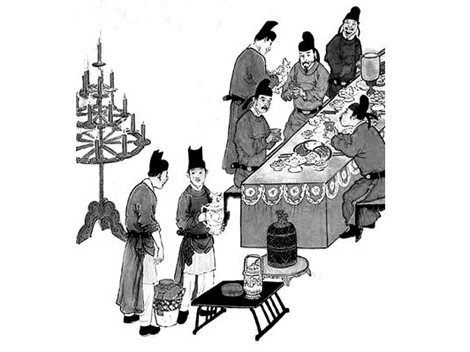 The Cold Food Festival or Hanshi Festival is a traditional Chinese holiday celebrated for three consecutive days starting the day before the Qingming Festival in the Chinese Calendar, which falls on the 105th day after dongzhi (April 5 by the Gregorian calendar, except in leap years). It is celebrated in China as well as the nearby nations of Korea and Vietnam. At this time of year, the sky becomes clearer and buds sprout in the field. Farmers sow various seeds and supply water to their rice paddies.
The Cold Food Festival or Hanshi Festival is a traditional Chinese holiday celebrated for three consecutive days starting the day before the Qingming Festival in the Chinese Calendar, which falls on the 105th day after dongzhi (April 5 by the Gregorian calendar, except in leap years). It is celebrated in China as well as the nearby nations of Korea and Vietnam. At this time of year, the sky becomes clearer and buds sprout in the field. Farmers sow various seeds and supply water to their rice paddies.
The Cold Food Festival started from the ancient tradition of setting fire by rubbing wood pieces together and the tradition of lighting new fires. Due to the change of seasons and the change in the type of wood available, the ancient practice was to change the type of fire-starter-wood used from season to season. Fire is lighted anew upon the start of each season. Before the new fire is officially started no one is allowed to light a fire. This was an important event during that time.
The traditionally practiced activities during the Cold Food Festival includes the visitation of ancestral tombs, cock-fighting, playing on swings, beating out blankets (to freshen them), tug-of-war, etc. The practice of visiting ancestral tombs is especially ancient.
In China ancestral worship used to be practiced during the time of the Cold Food Festival. It was later moved to coincide with the Qingming Festival. However in Korea, where the festival is called Hansik , the tradition of ancestral worship during the Cold Food Festival still remains.
In the modern version of Hansik, people welcome the warm weather thawing the frozen lands. On this day, rites to worship ancestors are observed early in the morning, and the family visits their ancestors’ tombs to tidy up.
Falling on the 105th day after the winter solstice (April 5 by the Gregorian calendar, except in leap years). At this time of year, the sky becomes clearer and buds sprout in the field. Farmers sow various seeds and supply water to their rice paddies. The custom of eating cold food on this day is believed to originate from a Chinese legend (see Tomb Sweeping Day), but recently this custom has disappeared.
Since this day coincides with Arbor Day, public cemeteries are crowded with visitors planting trees around the tombs of their ancestors.
In Vietnam, where it is called Tết Hàn Thực, the Cold Food Festival is celebrated by Vietnamese people in the northern part of the country on the third day of the third lunar month, but only marginally. People cook glutinous rice balls (see recipe and more info) called bánh trôi on that day but the holiday’s origins are largely forgotten, and the fire taboo is also largely ignored.
Source: Wikipedia
Qingming Festival (also known as Pure Brightness Festival or Tomb-sweeping Day), falls on either April 4th or 5th of the Gregorian calendar. The Chinese respect for filial piety and careful attention to funeral rites is visibly manifested in the custom of ancestor worship.
Since ancient times, a day has been designated for sweeping the tomb and honoring one’s ancestors. Though different in each family, these rites are usually performed on the first few days prior to or following Ching Ming, one of the traditional solar divisions falling in early April, when the frost retreats and spring returns bringing renewal to all living things.
When visiting the tomb, people usually bring the dead person’s favourite food and wine, and paper resembling money . This is in the hope that the deceased are not lacking food and money. After burning the paper money, tidying up the tomb, and putting willow branches around the gates and doors of the tomb to ward off evil spirits, people will eat the food and fruit before returning to their homes.
The folklore behind the story is as follows:
It is said that the Qingming Festival was originally held to commemorate a loyal man living in the Spring and Autumn Period (770 – 476 BC), named Jie Zitui. Jie cut a piece of meat from his own leg in order to save his hungry lord who was forced to go into exile when the crown was in jeopardy. The lord came back to his position nineteen years later, and forgot Jie Zitui but later felt ashamed and decided to reward him. However, Jie had blocked himself up in a mountain with his mother. In order to find Jie, the lord ordered that the mountain should be set on fire. Later Jie was found dead with his mother. In order to commemorate Jie, the lord ordered that the day Jie died was Hanshi (Cold Food) Festival – the day that only cold food could be eaten.
The second year, when the lord went to the mountain to sacrifice to Jie, he found willows revived, so he gave instructions that the day after Hanshi Festival was to be Qingming Festival. Later, the two festivals were combined as one.
Traditional Customs
Qingming Festival is a time of many different activities, among which the main ones are tomb sweeping, taking a spring outing, and flying kites. Some other lost customs like wearing willow branches on the head and riding on swings have added infinite joy in past days. The festival is a combination of sadness and happiness.
Cleaning the tomb and paying respect to the dead person with offerings are the two important parts of remembering the past relatives. Weeds around the tomb are cleared away and fresh soil is added to show care of the dead.
Today, with cremation taking over from burying, the custom has been extremely simplified in cities. Only flowers are presented to the dead relatives and revolutionary martyrs. No matter how respect is shown, good prayers for the deceased are expressed.
All in all, the Qingming Festival is an occasion of unique characteristics, integrating sorrowful tears to the dead with the continuous laughter from the spring outing.
From: Travel China Guide
The Veneralia (April 1) was the Ancient Roman festival of Venus Verticordia (“Changer of hearts”), the goddess of love and beauty. The worship of the goddess Fortuna Virilis (“Bold fortune”) was also part of this festival.
In Rome, jewelry was ritually removed from the statue of the goddess, her image was then taken from her temple to the men’s baths, where it was undressed and washed in warm water by her female attendants, then garlanded with myrtle.
Similarly, women bathed themselves in the public baths wearing wreaths of flowers and myrtle on their heads. It was generally a day for women to seek divine help in their relations with men. Men also asked Venus Verticordia for her help in affairs of the heart, sex, betrothal and marriage.
Here’s a nice ritual for the Day of Venus:
- Color: Sea green, golden, and pink
- Element: Water
- Altar: Upon cloth of sea green, golden and pink, set many shells, flowers, beautiful ornaments, pink candles, hearts, doves, incense of rose and violets, and a great chalice of white wine.
- Offerings: Hearts and flowers. Giving a gift of love to someone.
- Daily Meal: Seafood. Angel hair pasta. Sweet breads, cakes, and desserts.
Invocation to Venus
Hail, Lady of the Morning Star!
You who rose form the sea foam,
Born of the impersonal severed phallus of the sky
Immersed in the impersonal womb of the sea,
You who rode to shore on a shell of pearl
And whose powers no one can resist
Save the virgin goddesses,
You who bring the glow of gold
Into the lives of all whom you touch,
Lady, we revere you as the avatar
Of the love between equals
Who look each other in the eye,
The attraction and pursuit
Between every particle in the universe.
Hail, Lady of the Evening Star!
You who rule the night
With its darker passions,
You who tempt the wistful heart,
You whose hands reach out
To all the world and more,
Lady, we revere you as a force of nature
Far greater than merely the human heart,
For you are the force that binds together
All that dances with another of its kind
In the endless dance of creation.
(The wine is passed around, and poured as a libation to Venus. Each takes a flower and wears it in honor of Venus.)
Chant:
Venus Veritas
Amor Amor
Source: Wikipedia and Pagan Book of Hours
